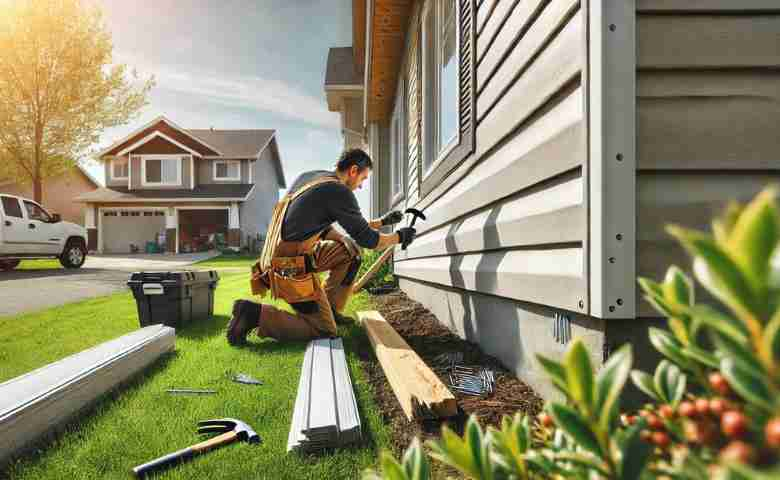Last Updated on November 14, 2024 by Admin
House siding protects your home from the elements while contributing to its aesthetic appeal. Over time, however, siding can become damaged or worn, requiring repairs to maintain its functionality and appearance. Whether you’re dealing with cracked vinyl, dented aluminum, or rotting wood, repairing house siding is a task that homeowners should approach with care. This comprehensive guide explores everything you need to know about repairing house siding, from identifying common issues to providing step-by-step instructions.
Table of Contents
Why Repairing House Siding is Essential
Your home’s siding is the first line of defense against weather conditions such as rain, wind, and extreme temperatures. Damaged or deteriorating siding can lead to several problems, including water infiltration, pest infestations, and increased energy costs. Repairing home siding promptly can help prevent these issues, preserve your home’s structural integrity, and enhance its curb appeal.
Common Types of House Siding
Before diving into repair methods, it’s important to understand the different types of siding materials commonly used in U.S. homes. Each material has its own unique repair needs:
- Vinyl Siding: Popular for its affordability and low maintenance, vinyl siding is prone to cracks and warping.
- Aluminum Siding: Durable and lightweight, aluminum siding can dent easily but is resistant to rust and decay.
- Wood Siding: Offers a classic look but is susceptible to rot, insect damage, and warping.
- Fiber Cement Siding: Known for its durability, fiber cement is resistant to rot and insects but can crack or chip over time.
- Stucco Siding: Common in southwestern states, stucco can crack due to settling or impact.
Identifying Siding Damage: What to Look For
Regular inspections of your house siding can help you catch issues before they become major problems. Here’s what to look for during your inspection:
1. Cracks and Holes
Small cracks and holes can appear in all types of siding, particularly in vinyl and stucco. These issues can allow water to penetrate the siding, leading to further damage.
2. Warping and Buckling
Vinyl siding is particularly prone to warping and buckling, often due to improper installation or exposure to excessive heat. Warped siding can compromise your home’s insulation and energy efficiency.
3. Dents and Dings
Aluminum siding is susceptible to dents from hail, falling branches, or other impacts. While these dents are mostly cosmetic, they can detract from your home’s appearance.
4. Rot and Decay
Wood siding is most vulnerable to rot and decay, especially in areas with high humidity or poor drainage. Rotting wood can attract insects and cause structural damage if not addressed promptly.
5. Peeling Paint or Loose Panels
Peeling paint or loose panels can be a sign of moisture infiltration or simply wear and tear over time. These issues can lead to further deterioration if not repaired.
DIY vs. Professional Repairs: When to Call in the Experts
Whether to tackle siding repairs yourself or hire a professional depends on the extent of the damage and your comfort level with home improvement projects.
DIY Repairs
DIY repairs can be a cost-effective solution for minor issues like small cracks, dents, or loose panels. Homeowners with some experience in home repair may feel confident fixing aluminum siding, replacing damaged vinyl panels, or sealing cracks in stucco.
Professional Repairs
Larger issues, such as extensive rot in wood siding, significant warping, or widespread damage from a storm, typically require the expertise of a professional. Repairing house siding that involves structural concerns or requires specialized tools is best left to a licensed contractor.
Financing Your Siding Repairs
For homeowners facing significant repair costs, exploring flexible loan options can be a practical way to manage expenses without straining finances. Many lenders offer personal loans tailored for home improvement projects, providing funds to help complete repairs efficiently and maintain your property’s value.
How to Repair House Siding: Step-by-Step Guide
Let’s walk through some common repair methods for various types of siding.
1. Repairing Vinyl Siding
Tools Needed: Vinyl siding removal tool, utility knife, replacement panels, hammer, nails.
- Identify the damaged area: Locate the cracked or warped section of vinyl siding.
- Remove the damaged panel: Use the vinyl siding removal tool to unlock the damaged panel from the panel below it. Gently lift and slide it out.
- Cut and install the replacement: Measure and cut the replacement panel to size. Slide it into place, ensuring it locks into the panel below. Secure it with nails, leaving a slight gap for expansion.
- Finish the repair: Lock the top of the replacement panel into the panel above it using the removal tool.
2. Fixing Aluminum Siding
Tools Needed: Metal snips, hammer, nails, paint, paintbrush.
- Assess the damage: Check for dents, dings, or loose panels.
- Remove the damaged panel: If the damage is extensive, remove the entire panel using metal snips or a similar tool.
- Straighten or replace the panel: For minor dents, use a rubber mallet to gently tap the dented area back into place. For more severe damage, replace the panel entirely.
- Paint if necessary: If the new panel is a different color, apply a coat of paint to match the existing siding.
3. Repairing Wood Siding
Tools Needed: Pry bar, circular saw, wood putty, replacement wood, nails, hammer, paint or stain.
- Identify and remove rotted wood: Use a pry bar to remove the rotted or damaged section of wood siding.
- Cut and install the replacement wood: Cut a new piece of wood to match the size of the removed section. Secure it with nails, ensuring it fits snugly.
- Seal and finish: Apply wood putty to seal gaps and nail holes. Once dry, sand it smooth and apply a coat of paint or stain to protect the wood.
4. Repairing Fiber Cement Siding
Tools Needed: Pry bar, circular saw with a diamond blade, replacement siding, nails, hammer, paint.
- Remove the damaged section: Use a pry bar to gently remove the damaged piece of fiber cement siding.
- Cut and install the replacement: Cut a new piece to fit the removed section, using a circular saw with a diamond blade. Secure it with nails, ensuring it aligns with the surrounding panels.
- Paint the repair: Apply a coat of exterior paint to match the existing siding.
5. Fixing Stucco Siding
Tools Needed: Stucco mix, trowel, putty knife, water.
- Clean the area: Remove any loose stucco or debris from the damaged area.
- Apply stucco mix: Mix a batch of stucco according to the manufacturer’s instructions. Use a trowel to apply the mix to the damaged area, smoothing it to match the surrounding texture.
- Let it dry and paint: Allow the stucco to dry completely before applying a coat of paint, if needed.
Maintenance Tips to Prevent Future Siding Damage
Proper maintenance is key to extending the life of your home’s siding and avoiding costly repairs. Here are some tips to keep your siding in top condition:
1. Regular Cleaning
Clean your siding at least once a year to remove dirt, mold, and mildew. Use a soft-bristle brush and a mixture of water and mild detergent for best results.
2. Inspect After Storms
After severe weather, inspect your siding for any damage. Look for loose panels, dents, or cracks that may have occurred during the storm.
3. Seal Gaps and Cracks
Regularly check for any gaps or cracks in your siding and seal them promptly to prevent water infiltration.
4. Trim Nearby Trees
Keep trees and shrubs trimmed away from your house to prevent branches from scratching or denting the siding.
5. Repaint or Restain
If you have wood siding, consider repainting or restaining it every few years to protect it from the elements and maintain its appearance.
Protect Your Investment with Timely Siding Repairs
Repairing house siding is an essential part of home maintenance that can protect your property from the elements, preserve its structural integrity, and enhance its curb appeal. Whether you’re fixing aluminum siding, replacing a damaged vinyl panel, or addressing wood rot, timely repairs can save you money and prevent more extensive damage down the line.
By following the tips and techniques outlined in this guide, you can confidently tackle most siding repairs on your own. However, don’t hesitate to consult with a professional if you’re dealing with more significant issues. Regular maintenance and prompt repairs are key to keeping your home’s siding in top condition, ensuring it continues to serve its protective and aesthetic functions for years to come.
Remember, your home is one of your most valuable investments. Taking the time to repair and maintain your siding is a small but crucial step in safeguarding that investment for the future.
Related Posts:
- Understanding the Importance of Exterior Siding in Sustainable Construction
- Cracks in Buildings: Understanding the Causes, Prevention, and Repair Methods
- Matching Your Garage Door: Key Elements
- Heavy Construction Equipment Repair in the USA
- Side Hustles for Construction Professionals: How to Diversify Your Income in the Industry


